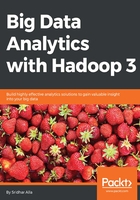
Inside the data analytics process
Once data is deemed ready, it can be analyzed and explored by data scientists using statistical methods such as SAS. Data governance also becomes a factor to ensure the proper collection and protection of the data. Another less well known role is that of a data steward who specializes in understanding the data to the byte; exactly where it is coming from, all transformations that occur, and what the business really needs from the column or field of data.
Various entities in the business might be dealing with addresses differently, such as the following:
123 N Main St vs 123 North Main Street.
But, our analytics depend on getting the correct address field, else both the addresses mentioned will be considered different and our analytics will not have the same accuracy.
The analytics process starts with data collection based on what the analysts might need from the data warehouse, collecting all sorts of data in the organization (sales, marketing, employee, payroll, HR, and so on). Data stewards and governance teams are important here to make sure the right data is collected and that any information deemed confidential or private is not accidentally exported out, even if the end users are all employees. Social Security Numbers (SSNs) or full addresses might not be a good idea to include in analytics as this can cause a lot of problems to the organization.
Data quality processes must be established to make sure that the data being collected and engineered is correct and will match the needs of the data scientists. At this stage, the main goal is to find and fix data quality problems that could affect the accuracy of analytical needs. Common techniques are profiling the data, cleansing the data to make sure that the information in a dataset is consistent, and also that any errors and duplicate records are removed.
Analytical applications can thus be realized using several disciplines, teams, and skillsets. Analytical applications can be used to generate reports all the way to automatically triggering business actions. For example, you can simply a create daily sales report to be emailed out to all managers every day at 8 AM in the morning. But, you can also integrate with business process management applications or some custom stock trading applications to take action, such as buying, selling, or alerting on activities in the stock market. You can also think of taking in news articles or social media information to further influence what decisions to be made.
Data visualization is an important piece of data analytics and it's hard to understand numbers when you are looking at a lot of metrics and calculation. Rather, there is an increasing dependence on business intelligence (BI) tools, such as Tableau, QlikView, and so on, to explore and analyze the data. Of course, large-scale visualization, such as showing all Uber cars in the country or heat maps showing water supply in New York City, requires more custom applications or specialized tools to be built.
Managing and analyzing data has always been a challenge across many organizations of different sizes across all industries. Businesses have always struggled to find a pragmatic approach to capturing information about their customers, products, and services. When the company only had a handful of customers who bought a few of their items, it was not that difficult. It was not as big of a challenge. But over time, companies in the markets started growing. Things have become more complicated. Now, we have branding information and social media. We have things that are sold and bought over the internet. We need to come up with different solutions. With web development, organizations, pricing, social networks, and segmentations, there's a lot of different data that we're dealing with that brings a lot more complexity when it comes to dealing, managing, organizing, and trying to gain some insight from the data.